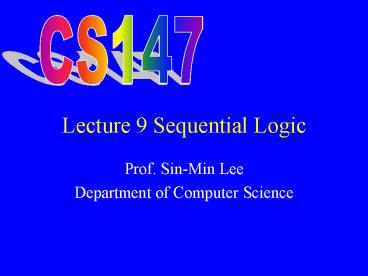Lecture 9 Sequential Logic - PowerPoint PPT Presentation
1 / 44
Title:
Lecture 9 Sequential Logic
Description:
Lecture 9 Sequential Logic Prof. Sin-Min Lee Department of Computer Science Dr. Montgomery Phister, Jr., an engineer under Dr. Nelson at Hughes, picked up the idea ... – PowerPoint PPT presentation
Number of Views:99
Avg rating:3.0/5.0
Title: Lecture 9 Sequential Logic
1
Lecture 9 Sequential Logic
CS147
- Prof. Sin-Min Lee
- Department of Computer Science
2
(No Transcript)
3
The origin of the name for the JK flip-flop is
detailed by P. L. Lindley, a JPL engineer, in a
letter to EDN, an electronics newsletter. The
letter is dated June 13, 1968, and was published
in the August edition of the newsletter. In the
letter, Mr. Lindley explains that he heard the
story of the JK flip-flop from Dr. Eldred Nelson,
who is responsible for coining the term while
working at Hughes Aircraft. Flip-flops in use at
Hughes at the time were all of the type that came
to be known as J-K. In designing a logical
system, Dr. Nelson assigned letters to flip-flop
inputs as follows 1 A B, 2 C D, 3 E
F, 4 G H, 5 J K. Given the size of the
system that he was working on, Dr. Nelson
realized that he was going to run out of letters,
so he decided to use J and K as the set and reset
input of each flip-flop in his system (using
subscripts or somesuch to distinguish the
flip-flops), since J and K were "nice, innocuous
letters."
4
- Dr. Montgomery Phister, Jr., an engineer under
Dr. Nelson at Hughes, picked up the idea that J
and K were the set and reset input for a "Hughes
type" of flip-flop, which he then termed "J-K
flip-flops," a name that he carried with him when
he left for Scientific Data Systems in Santa
Monica.
5
(No Transcript)
6
Implement D Flip-flop by T Flip-flop
Q
0 1
Q
0 1
D
T
0 1
0 1
0 0
0 1
1 0
1 1
T D Q D Q D
D
T
7
Implement JK Flip-flop by D Flip-flop
Q
0 1
Q
0 1
J K
J K
D
Q
- 0 1
- 0 0
- 0
- 1 1
0 0 0 1 1 1 1 0
0 0 0 1 1 1 1 0
- 0 1
- 0 0
- 0
- 1 1
0 1
0 1
D J Q K Q
Q
J
D
K
Q
8
Implement JK Flip-flop by T Flip-flop
Q
Q
Q
0 1
0 1
J K
Q
J K
J K
T
Q
- 0 1
- 0 0
- 0
- 1 1
0 0 0 1 1 1 1 0
0 0 0 1 1 1 1 0
- 0 0
- 0 1
- 1
- 1 0
0 0 0 1 1 0 1 1
Q 0 1 Q
Q Q
0 1
T J Q K Q
Q
J
T
K
Q
9
Implement T Flip-flop by JK Flip-flop
Q
J K
T
0 1
Q Q
0 1 1 0
0 X 1 X X 1 X
0
0 0 0 1 1 0 1 1
0 1
Q
Q
T
0 1
T
0 1
X 0 X 1
0 X 1 X
0 1
0 1
K T
J T
10
(No Transcript)
11
(No Transcript)
12
(No Transcript)
13
(No Transcript)
14
(No Transcript)
15
(No Transcript)
16
(No Transcript)
17
(No Transcript)
18
(No Transcript)
19
(No Transcript)
20
(No Transcript)
21
(No Transcript)
22
(No Transcript)
23
(No Transcript)
24
(No Transcript)
25
(No Transcript)
26
(No Transcript)
27
(No Transcript)
28
(No Transcript)
29
(No Transcript)
30
(No Transcript)
31
(No Transcript)
32
(No Transcript)
33
(No Transcript)
34
(No Transcript)
35
(No Transcript)
36
(No Transcript)
37
(No Transcript)
38
(No Transcript)
39
(No Transcript)
40
(No Transcript)
41
(No Transcript)
42
(No Transcript)
43
(No Transcript)
44
(No Transcript)































